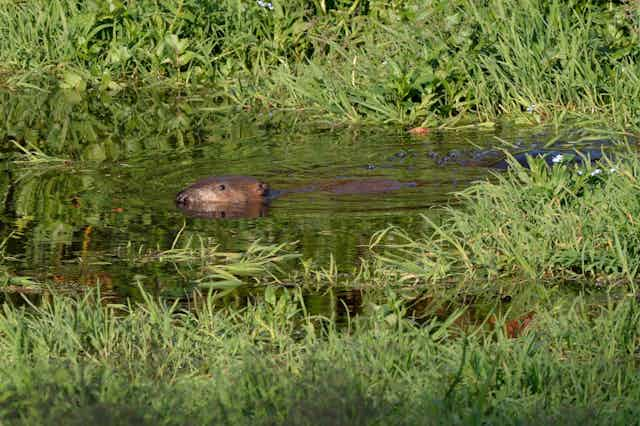What would rewilding mean for a country like the UK? Bringing back wolves and bears? Returning the land to how it looked in prehistoric times? How will people fit into this wild and unimaginably different place? Questions like these abound whenever rewilding is in the news.
You can listen to more articles from The Conversation, narrated by Noa, here.
In essence, rewilding involves giving more space and time to nature. Instead of managing ecosystems to preserve particular species, rewilding is intended to reverse environmental decline by letting nature become more self-willed. That means allowing wildlife the freedom to flourish and habitats to regenerate naturally.
But without clear principles to guide these processes, rewilding has become a trendy buzzword that is often used indiscriminately. This has invited wildly different interpretations, sparked debates and caused controversy that has discouraged governments from developing it into policy.
This could be about to change though.
We’ve published a set of guiding principles which specify what rewilding should involve and how it should be done. This is the result of one of the most comprehensive international studies on rewilding to date, reviewing best practices and the latest science, instigated by the International Union for the Conservation of Nature and involving hundreds of experts. Without further ado, here are the dos and don'ts of rewilding.

Don’t (always) start with wolves
The objective of rewilding is boosting the health of an ecosystem by increasing the number of species and how much they can all interact. A fully restored ecosystem would have top predators, but there are a lot of missing parts – the plants, prey animals, fungi – that should be put back first to ensure that larger species have an appropriate food source and habitat to support them.
It might not be appropriate for lots of other reasons to reintroduce wolves to a particular place at the moment, but in the meantime, bringing back beavers, lizards and butterflies is brilliant too.

The UK government has the chance to support the reintroduction of species by including funding for it in its new environmental land management schemes. As opposed to the EU’s Common Agricultural Policy, which paid farmers a subsidy based on the size of the land they owned, the new schemes would offer payments to farmers and land managers in return for supporting nature recovery across the landscape.
Within these schemes, funding could be allocated for the natural regeneration of habitats, instead of interventions like tree planting. This would mean moving away from setting fixed targets and managing habitats to suit one species, which might feel risky, but it would let scientists see how natural processes operate when they are given room, and what unexpected things arrive. This can change our understanding of how ecosystems work and where species can thrive if landscapes become healthier.
Do reconnect people with nature
Rewilding involves reducing harmful human pressures and promoting natural processes in ecosystems. This shouldn’t mean excluding people though. Rewilding should actually help people develop a more positive relationship with the natural world that involves compassion for all species and a spirit of learning from nature rather than seeking to dominate it.
This can be done through school trips, holidays in rewilding sites and voluntary work opportunities like tree planting, wetland restoration and wildlife surveys. A greater emphasis on the natural world in primary and secondary education could also help guarantee the long-term success of rewilding efforts by nurturing enthusiasm from an early age.
Read more: Forget environmental doom and gloom – young people draw alternative visions of nature's future
Don’t alienate rural communities
The prospect of rewilding has made some people in the countryside anxious. Farmers in particular worry that their livestock, land and way of life are under threat, either from reintroduced predators or new directives to manage the land differently.
Including local people at every stage of a rewilding project is very important. To ensure this, staff working on rewilding projects need to be based locally so they are available for a chat or to discuss concerns. They shouldn’t just rely on formal consultation – where communities fill in surveys or participate in organised meetings.
Ideally, rewilding projects should be driven by local people who could organise and set the agenda for how their land is managed. They should also directly benefit from associated businesses, like wildlife tours.

Do think about the future
Some people worry that rewilding harks back to a time before modern man or even earlier – to when woolly mammoths stalked the Earth. Looking back can allow us to see what has been lost and what could be revived, but rewilding isn’t about rewinding the clock. It’s about looking to the future and the challenges nature will face.
By enabling species to move through reconnected habitats and traverse entire landscapes, wildlife populations can be rebuilt. This would ensure the healthy functioning of an ecosystem isn’t dependent on a few isolated creatures, and it’s a practical way to help nature adapt to threats like climate change and new diseases, as species will have more freedom to move if pressures in one place escalate.
The UK government has committed to protect 30% of UK land by 2030 by creating new national parks and Areas of Outstanding Natural Beauty. But landowners need commitments from the government and funders so they know that restoring woodland and wetlands won’t cost them money down the line. Conservation covenants – introduced in the 2020 Environment Bill – could provide a mechanism for landowners to stipulate how their estate is managed in perpetuity. So land can become, and remain, wild hundreds of years into the future.

